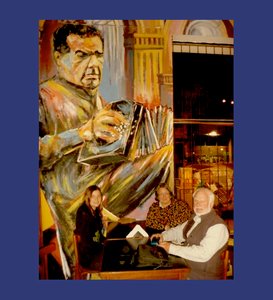Advertisement
Published: February 28th 2010

 Sanata Bar
Sanata Bar
The box accordion is the instrument of Argentine tango.TANGO had just been inscribed by Unesco as an item on it’s list of Representative List of the Intangible Cultural Heritage of Humanity.. The city council of Montevideo celebrated the inscription with free concerts at the front of the Intendencia Municipal de Montevideo (City Hall) on three successive evenings last October.
I have no photographs, but picture a stage erected from scaffolding and swathed in black. On it assembles a casually dressed band. Stage left a man sits at a keyboard. Four violinists stand at the back. A double bass player and a cellist are stage right. In front of the four violinists sit a line of four box-accordion players. This is a tango band from Buenos Aires, visiting to share this triumph of the music of the Río de la Plata. It rather gives the lie to the gossip that there is animosity in the rivalry between Argentine Buenos Aires and Uruguayan Montevideo over which city really gave birth to this music.
Whatever the truth, the Buenos Aires suburb of La Boca is making a small fortune out of its claim. Originally, a slum that housed the dockworkers who were the earliest dancers and musicians, La Boca homes

 Sanata Bar
Sanata Bar
Phil stands outside our favourite bar under a picture of Carlos Gardel.were built out of recycled building materials and sheets of corrugated iron. To brighten them up the workers used whatever bits of paint they could find. Now, the streets hold cafés and souvenir shops with garish facades, and demonstrations of tango dancing are staged all day on the pavements. The men wear the suits and hats of the mid twentieth century and the women tight satin dresses with high-slit skirts. The men lead their partners through series of intricate steps and kicks to the rousing music of a fiddle and an accordion.
That is tourist tango. The real tango is danced in the milongas from late night through to the dawn hours throughout the city. That is where the aficionados go to perfect their steps and to observe the new trends.
Another district that has ties to tango history is the inner-city suburb of Arbasto. This slightly decayed neighbourhood is where the greatest exponent of the tango bought a house for his mother and lived with her until his death in 1935. Carlos Gardel is Latin America’s answer to Frank Sinatra (he was twenty-five years older than Sinatra). Gardel is honoured with a museum, a bronze statue outside

 Abasto
Abasto
Old time tango dancers in a photo in the Carols Gardel museum.a nearby milonga (tango venue), and with his name given to the nearby subte (underground railway) station. His face is painted on numerous walls.
A few blocks away his face is painted on the outside of the Sanata Bar. It was our “local” while we stayed in BA. This old building is a corner block squeezed between apartment buildings and functions both as a local café and a music venue. Tango bands and singers play there every night, drawing their own followings from across they city. Two nights a week there is dance tuition. No satin skirts, no fancy kicks: just ordinary couples in ordinary clothes dancing in tango rhythm.
Which is what made the event at the Montevideo City Hall come alive. On the concrete in front of the stage the spectators left a little space. Couples came into that space as they chose and danced out the sets. A few were good tango dancers, many were beginners and a few were inventing it as they went.
Argentina and Uruguay dispute the birthplace of the dance and they also dispute ownership of Carlos Gardel, claiming that he was born in their country (some websites say France). Whatever

 La Boca
La Boca
Musicians play while ...the truth this wonderful dance belongs in both counties. Tango is both cultural heritage and social exchange in the Río de la Plata.
Second of three. There are photos of La Boca in The Subte of Buenas Aires.
Travel Notes
Montevideo is across the River (Rio de la Plata) from Buenos Aires. Ferries take one to two hours. Immigration formalities are fairly fast. For my accommodation in Montevideo I relied on Couchsurfing. Simple, cheap, friendly, and fun.
Advertisement
Tot: 0.069s; Tpl: 0.013s; cc: 8; qc: 25; dbt: 0.0349s; 1; m:domysql w:travelblog (10.17.0.13); sld: 1;
; mem: 1mb

 Sanata Bar
Sanata Bar
 Sanata Bar
Sanata Bar
 Abasto
Abasto
 La Boca
La Boca


























